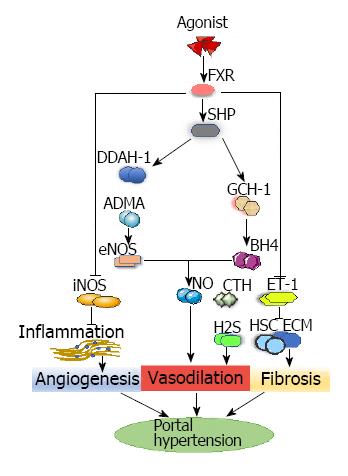Copyright
©The Author(s) 2018.
World J Clin Cases. Sep 26, 2018; 6(10): 335-343
Published online Sep 26, 2018. doi: 10.12998/wjcc.v6.i10.335
Published online Sep 26, 2018. doi: 10.12998/wjcc.v6.i10.335
Figure 3 FXR-mediated pathways in angiogenesis, vasodilation and fibrosis during portal hypertension.
FXR pathway: FXR agonist enhances the expression of FXR, which enhances the expression of DDAH-1 and GTP cyclohydrolase-1. DDAH-1 can reduce the levels of ADMA and upregulate the expression of eNOS. GTP cyclohydrolase-1 can increase the expression of BH4. This synergistic enhancement of eNOS and BH4 activity has improved nitric oxide-mediated sinus endothelial function. In addition, FXR agonism reduces the inflammatory response by reducing the expression of iNOS and cyclooxygenase 2 to improve PHT. FXR agonism decreases the expression of endothelin-1 and then inhibits HSC proliferation and extracellular matrix synthesis, which can ameliorate fibrosis. Repressed endothelin-1 can increase the production of cystathionase-mediated hydrogen sulfide, which can cause vasodilation. ADMA: Asymmetric dimethylarginine; BH4: Tetrahydrobiopterin; DDAH-1: Dimethylarginine dimethylamidohydrolase-1; ECM: Extracellular matrix; eNOS: Endothelial nitric oxide synthase; FXR: Farnesoid X receptor; GCH-1: GTP cyclohydrolase-1; H2S: Hydrogen sulfide; HSC: Hepatic stellate cell; iNOS: Inducible nitric oxide synthase; NO: Nitric Oxide; SHR: Small heterodimer partner.
- Citation: Xu W, Liu P, Mu YP. Research progress on signaling pathways in cirrhotic portal hypertension. World J Clin Cases 2018; 6(10): 335-343
- URL: https://www.wjgnet.com/2307-8960/full/v6/i10/335.htm
- DOI: https://dx.doi.org/10.12998/wjcc.v6.i10.335









